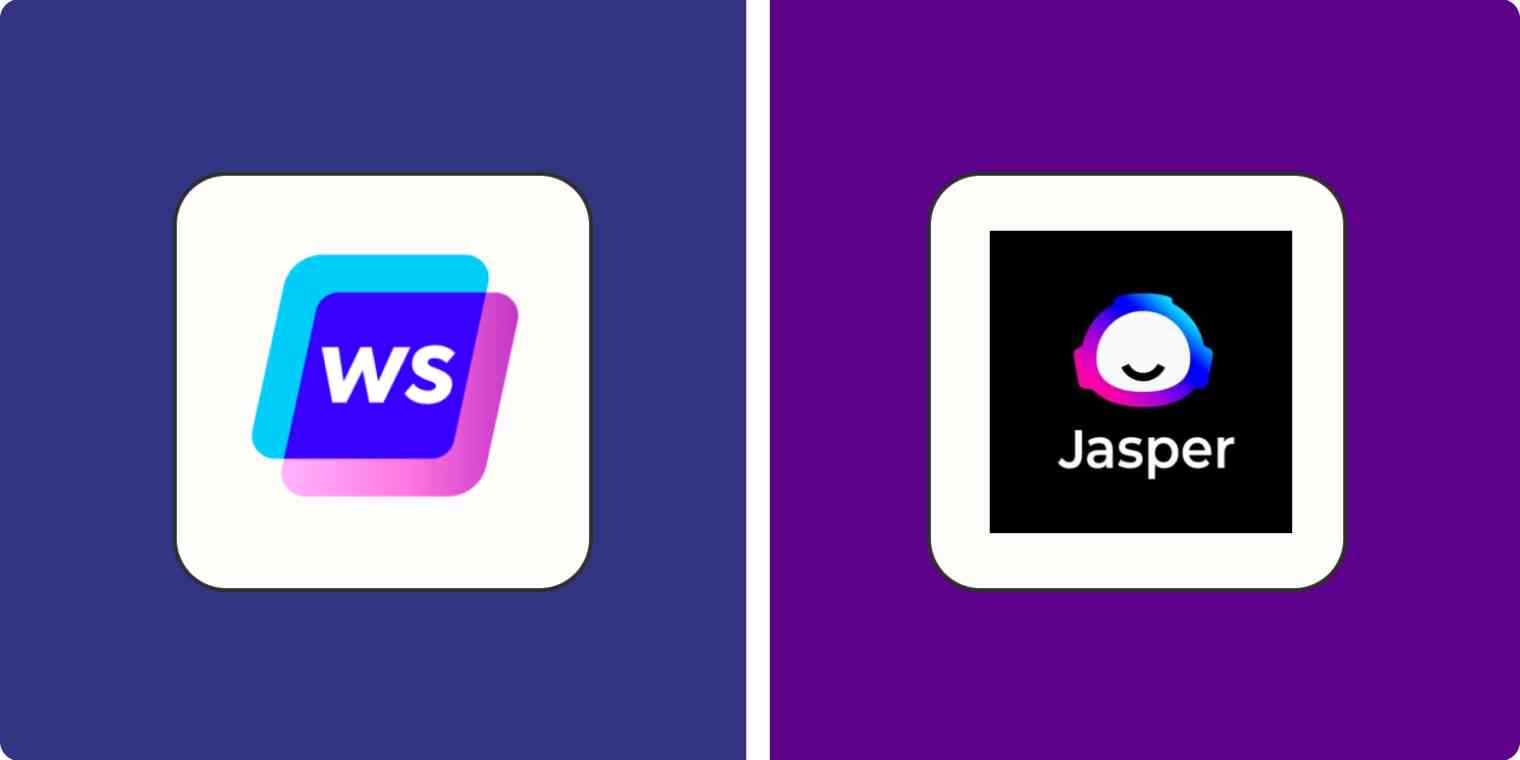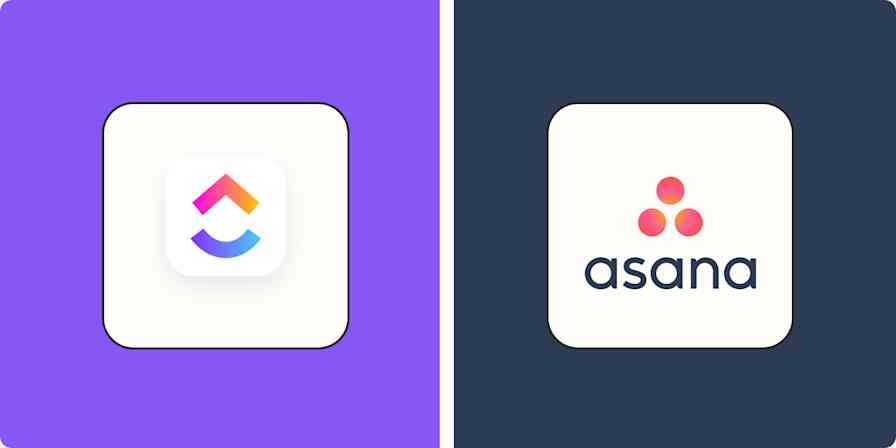I've been using Jasper regularly since 2021, and there's no denying it's one of the best AI writing tools on the market. But recently, I decided to try out another AI content tool: Writesonic. As it turns out, it's a solid Jasper alternative. Both apps produce quality content, but they approach the process differently.
I spent time digging deeper into both apps to see how their features and workflows stack up. Here's what I discovered in the Jasper vs. Writesonic showdown.
Writesonic vs. Jasper at a glance
Here's the gist: if you want more personalization and control over the content output you get, Jasper is the way to go. It has some excellent templates to work off of, but it also lets you go freeform a lot easier—that flexibility can be really important in the content creation process. That said, Writesonic serves a very clear purpose: its templates and workflow will help you go from ideation to finished content very quickly. Read on for more details from my experience using both apps.
| Jasper | Writesonic |
|---|---|---|
Quality of output | Powered by Open AI, PalM (Google), Anthropic, Cohere, Jasper | Powered by Open AI |
Best for | Experienced marketers who want more control | Beginners, or those looking for a hands-free experience |
Templates | ⭐⭐⭐⭐⭐ 50+ solid templates | ⭐⭐⭐⭐⭐ 100+ templates |
Ease of use | ⭐⭐⭐⭐ Takes a few trials to get it right (because of advanced features) | ⭐⭐⭐⭐⭐ Incredibly easy to use |
Customization and flexibility | ⭐⭐⭐⭐⭐ Allows you to fine-tune the AI workflow to suit your needs | ⭐⭐⭐ More rigid framework |
Integrations and supported platforms | ⭐⭐⭐⭐⭐ Integrates with Zapier, Surfer SEO, plagiarism checker, and DALL-E | ⭐⭐⭐⭐⭐ Integrates with Zapier, Surfer SEO, plagiarism checker, DALL-E, and WordPress |
Pricing | ⭐⭐⭐⭐ No free plan and more expensive | ⭐⭐⭐⭐⭐ Freemium model with low monthly cost |
Jasper and Writesonic are powered by different AI models, but the output quality is similar
The latest version of GPT released by Open AI is called GPT-4, and people are pretty excited about it. Most AI writing tools are still powered by GPT-3.5 (which is astounding in its own right), but Jasper and Writesonic have both integrated the updated model into their AI engines. In theory, this means that the content outputs you get from them are more accurate and sound more like a human.
There is a difference here, though:
Jasper automatically selects the AI model it thinks is best for your project, which may or may not be GPT-4.
Writesonic, on the other hand, allows you to choose the AI model you want to apply: GPT-3.5, GPT-4, or the forthcoming GPT-4+.
Here's Jasper's announcement, and it tracks: when using Jasper, there's nowhere to select your model.
Jasper’s AI Engine gives you instant access to the world's best models, including GPT-4 + an array of others, as soon as they launch.
— Jasper (@heyjasperai) March 14, 2023
Our engine automatically selects the right model for the job, then layers in Google facts, SEO tools, and more.
And here's Writesonic's interface, where you can choose which model you want.
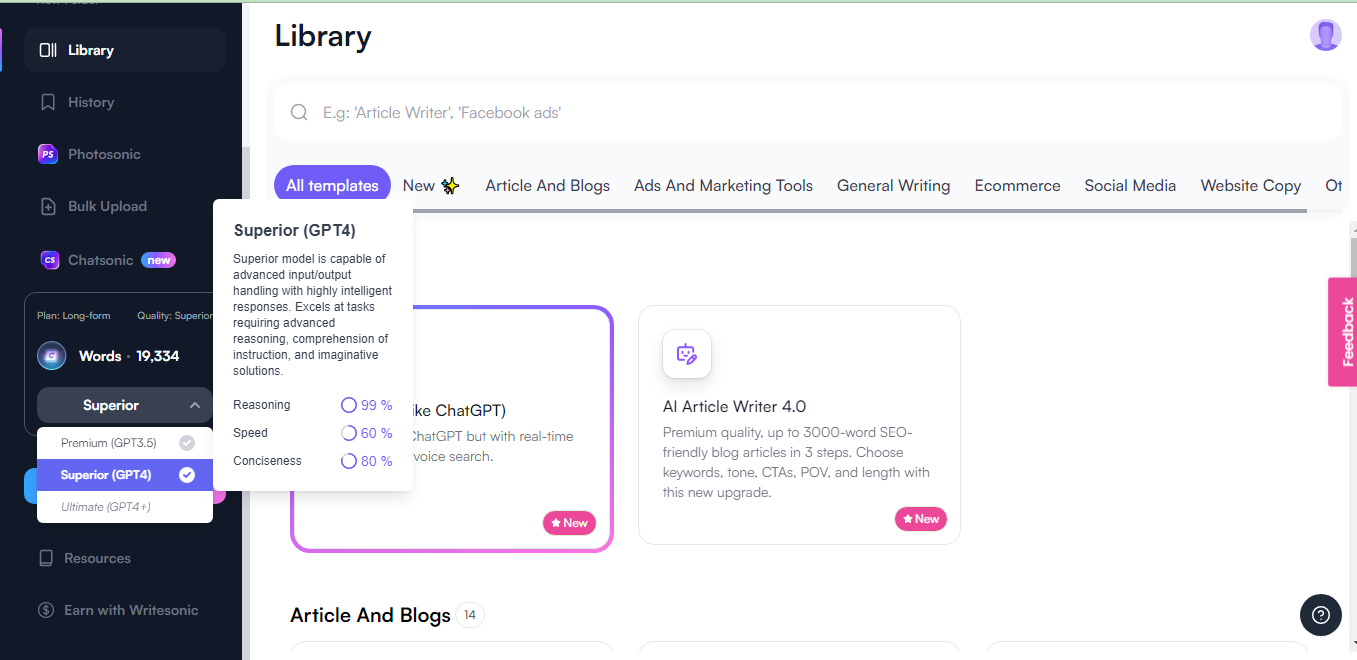
Jasper has some other models working under the hood too. In addition to OpenAI, it's using PalM (Google), Anthropic, Cohere, and its own model. That could mean a bit more adaptability, but I didn't notice any significant difference in content quality on the two app. But Writesonic's transparency—and the ability to control it yourself—is a huge bonus, I think.
Writesonic is more beginner-friendly
Writesonic and Jasper offer a smooth user experience, but Writesonic's workflow makes it more suitable for beginners. When you first sign in to Writesonic, you'll immediately see all its templates neatly organized into categories.
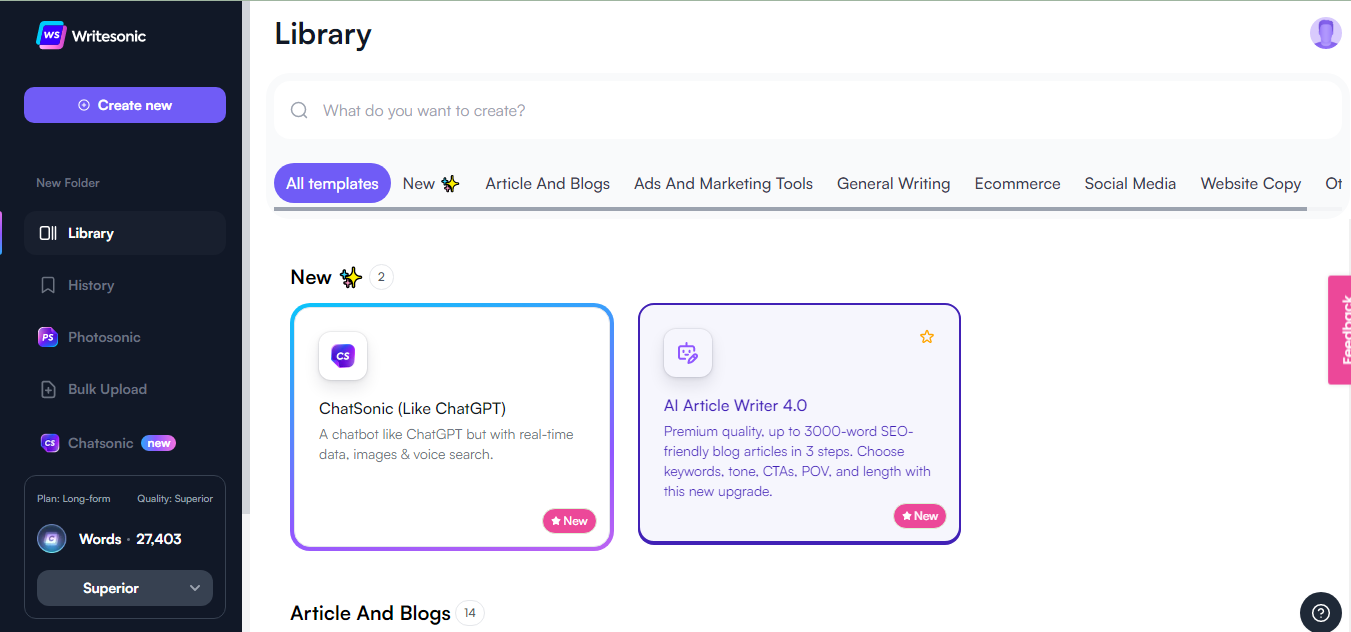
To get started, you just select a template, provide details about what you need, and hit generate. Boom—the tool spits out content for you. It's a very hands-free experience, great for those just dabbling into generative AI or who aren't as skilled at prompting yet.
For example: let's say you want to write a long-form article. Once you select an article template in Writesonic (e.g., AI article writer 4.0), all you need to do is provide your topic and keywords, and it'll generate title ideas, an outline, and a full SEO-friendly blog with a stock photo. If you're yet to do keyword research, the template can even provide a list of potential keywords for your article (whether these keywords are relevant or not is for you to figure out).
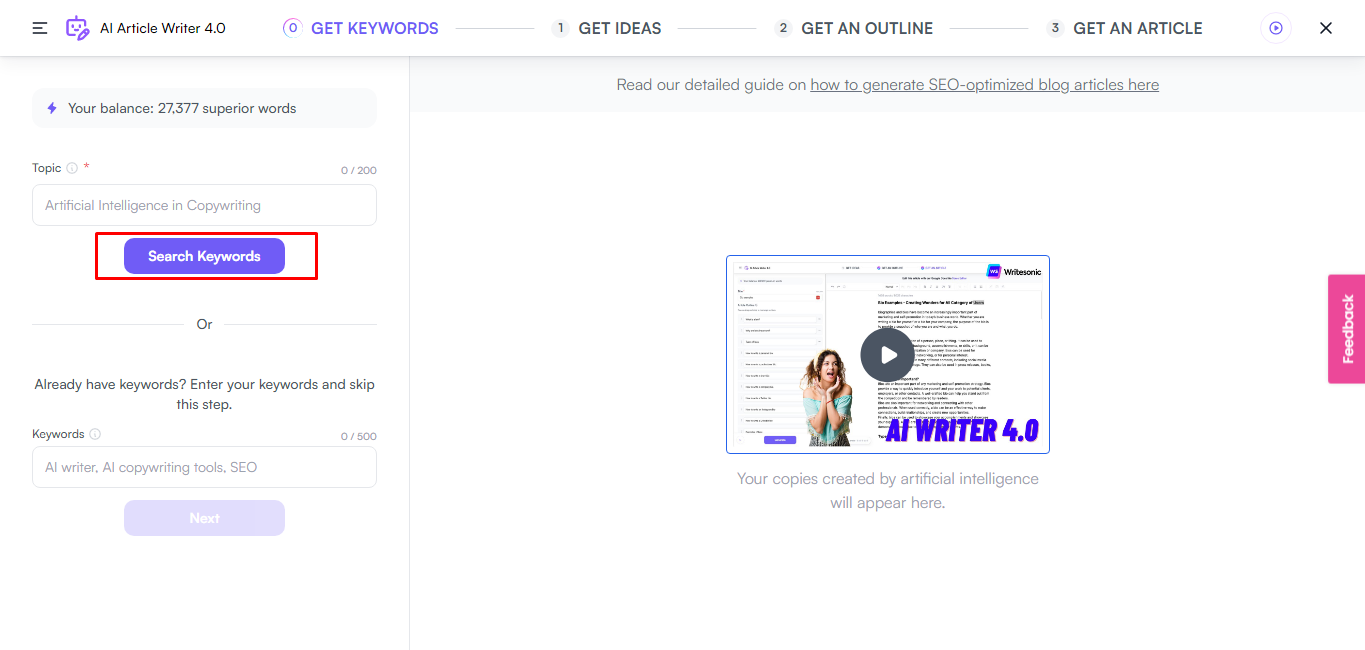
The entire workflow boils down to something like select template > input details > get content. It varies a bit based on the template, but they're all straight to the point like this.
Jasper, on the other hand, has a more complicated process. When you navigate to the blog category from your dashboard, you'll find templates for sections like intro, topic, and conclusion. Seasoned content writers will appreciate this approach because it offers more control to the human writer, but it may be too much for a newbie looking to generate a complete article from scratch.
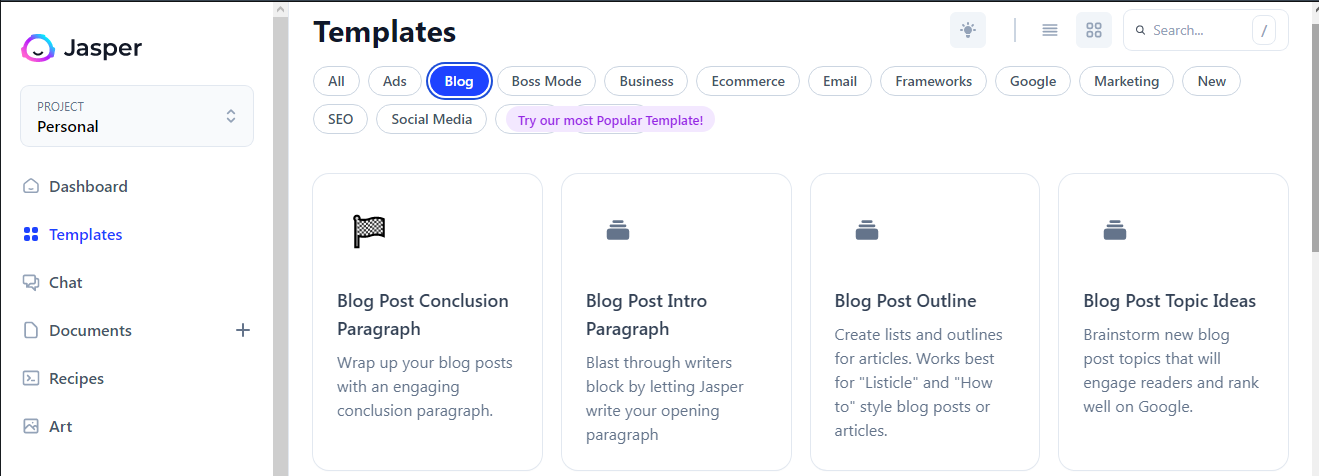
If you want to generate a full article on Jasper, you can, but it's less straightforward. From your dashboard, you'll click to Create new content and then select New document.
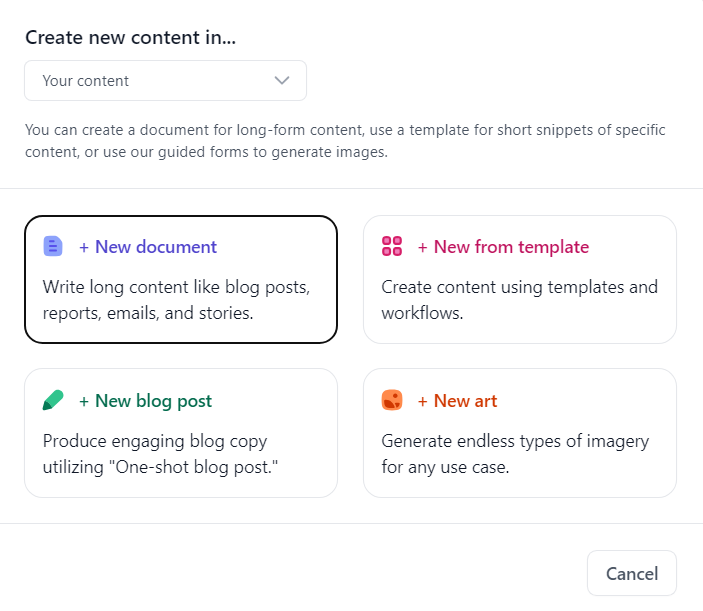
It'll open a blank page like Google Docs, where you can work alongside Jasper to create content from scratch using commands and prompts. In the blank page, you'll choose between three modes:
Focus mode allows you to co-write with Jasper.
Chat mode turns Jasper into a friendly chatbot like ChatGPT.
Power mode opens a drawer of templates (workflows) for creating different types of content.

Honestly, I was a bit confused the first few times I used the tool—I had to head over to their boot camp to watch a few videos. The upside to Jasper's more complicated workflow is that the input fields (in templates) end up being more structured. With fields like Audience, for example, the final output tends to be more relevant—it forces you to answer the questions a solid content marketer should.
In the end, Jasper gives you a lot of options, which is great. But if you need a quick fix, Writesonic will be right up your alley.
Jasper is more flexible and offers more control
Both Writesonic and Jasper have an impressive selection of pre-bundled templates that can handle the entire content creation process. But Jasper's "new document" model is a huge asset for advanced marketers who prefer to be more involved in the process. And arguably, humans should be more involved in the process.
As I mentioned above, selecting New document will open up a blank page similar to Google Docs. From there, you can interact and co-write with Jasper AI using the Focus or Chat mode. In either case, it serves as an AI writing assistant that can take commands and work however you want.
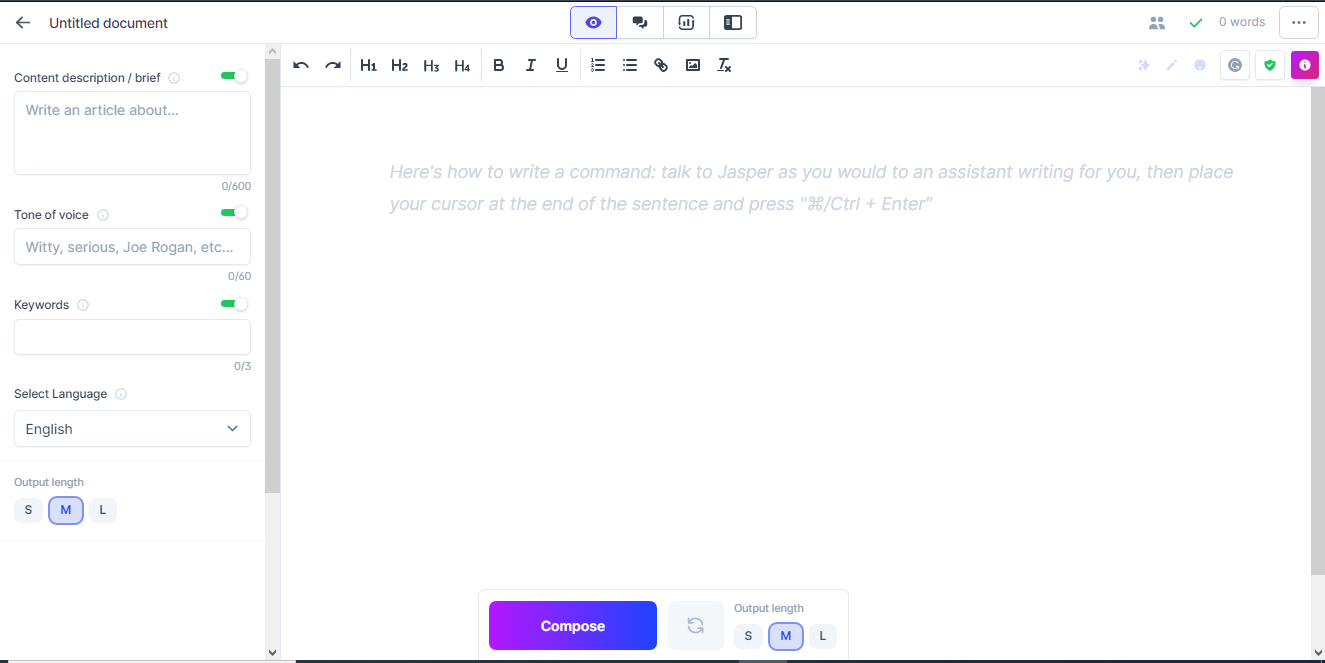
In Focus mode, put on your creative hat, and command Jasper to write in a specific style or like a specific person. As the AI tool writes, you can add context, tweak outputs, iterate inputs, and direct it on what to do—or not to do. Jasper will generate short, medium, or long content depending on the specified output length when you run a command. If you want it to add more content, click Compose.
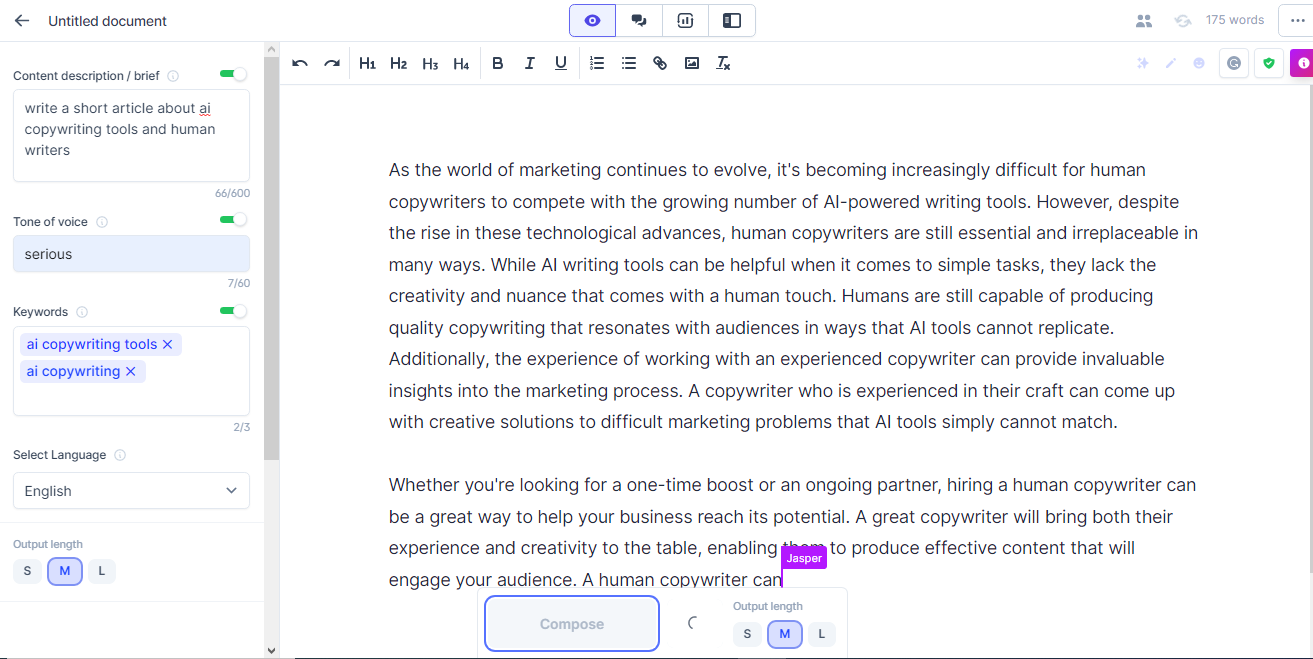
In Chat mode, Jasper becomes a chatbot like ChatGPT. You can converse with it using prompts or speak to it like a real-life writing assistant with voice commands. Jasper Chat can even search the internet to find information as it works—just toggle the Include search button when you run a command.
In addition to the regular tone of voice you select when using the tool, you can teach Jasper your brand tone, style, and key company details. It'll save and use this information to create content that's on brand every time you run a command or use a template. It's not perfect, but it will produce outputs that feel more like you.
As you create commands and workflows on Jasper, you can save them as recipes (pre-built workflows) for a repeatable process. And if you struggle to come up with the right prompts, there's an avalanche of recipes available in the Jasper community that you can use until you develop yours. Here's an example.

Mastering the art of giving Jasper the right commands takes some practice. But once you get into it, you'll be impressed by the level of personalization and creativity you'll unlock.
Writesonic also has a brand voice feature, but unlike with Jasper, I didn't notice any significant difference when I used it. So if you plan on making AI writing tools a vital part of your content marketing workflow, you’ll find more value in Jasper. The ability to fine-tune and work with the bot in the document editor ensures you get truly unique content that's personalized and suitable for your use case.
One last note: Jasper also offers more control in its AI art generator. You can specify the mood, style, and medium you want your art in—it prompts you to get specific. If you want Jasper to draw inspiration from Pablo Picasso or Norman Rockwell, just choose from the list of famous artists and painters. You can specify this kind of detail in your prompt when using Writesonic (which uses the same AI image model), but Jasper helps you along by offering you a list. Jasper also always offers four outputs, so you have options.
Writesonic is more affordable (and offers a generous free plan)
At first glance, Jasper's and Writesonic's pricing plans appear similar because they have three tiers—but they're actually very different.
Writesonic's pricing scales with your word count needs. The free plan includes 10,000 words/month and access to all 100+ of its templates. It runs on GPT-3.5 and excludes features like bulk processing and Surfer SEO integration, but it's still a relatively generous free plan, especially compared to Jasper, which doesn't have a free plan at all.
For paid plans, Writesonic starts at $19/month, and you get 100,000 words with one user seat. It unlocks GPT-4 and GPT-4+ (when it arrives). If you want more users or more words, the next option is $49/month for 300,000 words. As your word count needs increase, so do the price and number of user seats.
Jasper is noticeably pricier, but it has no word count limits. Instead, the pricing depends on functionality and user seats. Plans start at $49/month, and at this price, you can generate unlimited words using its 50+ templates and document mode. But you can't use SEO mode, save your workflow as recipes, or access any pre-built recipes. You also get one default brand voice, one user seat, and very limited memory. If you want more, you'll need to buy a higher plan: Teams, which starts at $125/month for three user seats, three brand voices, and 150 memories. After that, you'll need to speak to sales for a custom price with even more sophisticated features.
One last thing that's worth mentioning: with Writesonic, the number of words you get on a particular plan depends on the quality type. If you choose Premium quality (GPT-3.5), you get those 60,000 words for $19/month. But once you switch to a higher quality (Superior GPT-4 or Ultimate GPT-4+), your word count drops by half.
The difference in features and pricing is clear. If you're a freelancer, blogger, or business on a budget, Writesonic is your best bet. But when control and flexibility matter, Jasper has more value to offer.
Writesonic has more native integrations, but both apps integrate with Zapier
Writesonic integrates with Surfer for SEO, DALL·E for image generation, and Copyscape for plagiarism checking—and it connects to WordPress in one click.
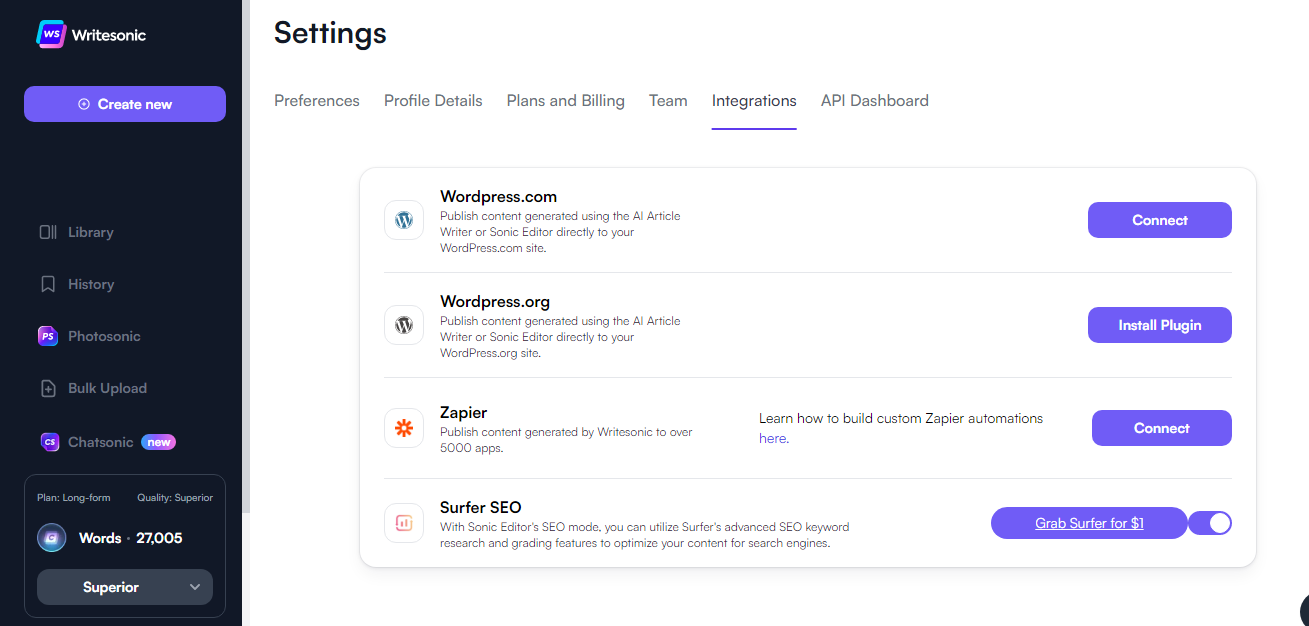
Jasper, on the other hand, integrates with Surfer, DALL·E, and Copyscape but not WordPress or any other blogging platform.
That said, they both integrate with Zapier (though, on Jasper, you'll need to buy the Business plan to access this integration, whereas Writesonic offers it on all plans).
Writesonic's Zapier integration lets you kick off workflows straight from Writesonic. Learn more about how to automate Writesonic, or try this pre-built workflows below.
Create a Google Doc with new content from Writesonic
Generate product descriptions with Writesonic from spreadsheet rows in Google Sheets
Jasper's Zapier integration, on the other hand, works the other way around—you can kick off workflows in Jasper (create a blog post or product description, run a command, or summarize content) from all the other apps you use most. Learn more about how to automate Jasper, or try one of the pre-built workflows below.
Create product descriptions in Jasper from new or updated Airtable records
Create Jasper blog posts from new changes to specific column values in monday.com and save the text in Google Docs documents
Run Jasper commands and send Slack channel messages with new pushed messages in Slack
Zapier is a no-code automation tool that lets you connect your apps into automated workflows, so that every person and every business can move forward at growth speed. Learn more about how it works.
Jasper vs. Writesonic: Which should you use?
Either Writesonic or Jasper would be a great addition to any content marketing tech stack, but they're ideal for different scenarios. Jasper is better for experienced marketers with a budget, who want more control over the output. Writesonic serves more inexperienced marketers who need some hand-holding (and don't have a budget)—and it's the best choice if you want to be sure your AI writing tool integrates with the rest of your tech stack.
Related reading:
This article was originally published in April 2023. The most recent update was in June 2023.
